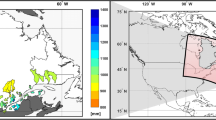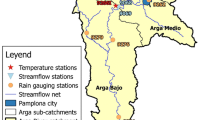Abstract
This paper investigates the uncertainty in the impact of climate change on flood frequency in England, through the use of continuous simulation of river flows. Six different sources of uncertainty are discussed: future greenhouse gas emissions; Global Climate Model (GCM) structure; downscaling from GCMs (including Regional Climate Model structure); hydrological model structure; hydrological model parameters and the internal variability of the climate system (sampled by applying different GCM initial conditions). These sources of uncertainty are demonstrated (separately) for two example catchments in England, by propagation through to flood frequency impact. The results suggest that uncertainty from GCM structure is by far the largest source of uncertainty. However, this is due to the extremely large increases in winter rainfall predicted by one of the five GCMs used. Other sources of uncertainty become more significant if the results from this GCM are omitted, although uncertainty from sources relating to modelling of the future climate is generally still larger than that relating to emissions or hydrological modelling. It is also shown that understanding current and future natural variability is critical in assessing the importance of climate change impacts on hydrology.
Similar content being viewed by others
References
Alila Y, Mtiraoui A (2002) Implications of heterogeneous flood-frequency distributions on traditional stream-discharge prediction techniques. Hydrol Process 16:1065–1084
Arnell NW (1999) The effect of climate change on hydrological regimes in Europe: a continental perspective. Glob Environ Change 9:5–23
Arnell NW (2003) Relative effects of multi-decadal climatic variability and changes in the mean and variability of climate due to global warming: future streamflows in Britain. J Hydrol 270:195–213
Arnell NW, Hudson D, Jones RG (2003) Climate change scenarios from a regional climate model: estimating change in runoff in southern Africa. J Geophys Res 108(D16):4519. doi:10.1029/2002JD002782
Bayliss A, Jones R (1992) The peaks-over-threshold database at the Institute of Hydrology. Report to UK Ministry of Agriculture, Fisheries and Food, Institute of Hydrology, Wallingford, 74 pp
Begueria S (2005) Uncertainties in partial duration series modelling of extremes related to the choice of the threshold value. J Hydrol 303:215–230
Bell VA, Kay AL, Jones RG, Moore RJ (2007a) Development of a high resolution grid-based river flow model for use with regional climate model output. Hydrol Earth Syst Sci 11:532–549
Bell VA, Kay AL, Jones RG, Moore RJ (2007b) Use of a grid-based hydrological model and regional climate model outputs to assess changing flood risk. Int J Climatol 27(12):1657–1671
Beven KJ (2001) Calibration, validation and equifinality in hydrological modelling. In: Anderson MG, Bates PD (eds) Model validation: perspectives in hydrological science. Wiley, Chichester, pp 43–44
Booij MJ (2005) Impact of climate change on flooding assessed with different spatial model resolutions. J Hydrol 303:176–198
Cameron D (2006) An application of the UKCIP02 climate change scenarios to flood estimation by continuous simulation for a gauged catchment in the northeast of Scotland, UK (with uncertainty). J Hydrol 328:212–226
Cameron D, Beven K, Naden P (2000) Flood frequency estimation by continuous simulation under climate change (with uncertainty). Hydrol Earth Syst Sci 4:393–405
Christensen JH, Carter TR, Rummukainen M, Amanatidis G (2007) Evaluating the performance and utility of regional climate models: the PRUDENCE project. Clim Change 81:1–6
Déqué M, Rowell DP, Lüthi D, Giorgi F, Christensen JH, Rockel B, Jacob D, Kjellström E, de Castro M, van den Hurk B (2007) An intercomparison of regional climate simulations for Europe: assessing uncertainties in model projections. Clim Change 81:53–70
Durman CF, Gregory JM, Hassell DC, Jones RG, Murphy JM (2001) A comparison of extreme European daily precipitation simulated by a global and a regional climate model for present and future climates. Q J R Meteorol Soc 127(573):1005–1015
Ekstrom M, Jones PD, Fowler HJ, Lenderink G, Buishand TA, Conway D (2007) Regional climate model data used within the SWURVE project 1: projected changes in seasonal patterns and estimation of PET. Hydrol Earth Syst Sci 11(3):1069–1083
Fowler HJ, Kilsby CG (2007) Using regional climate model data to simulate historical and future river flows in northwest England. Clim Change 80:337–367
Graham LP, Andreasson J, Carlsson B (2007a) Assessing climate change impacts on hydrology from an ensemble of regional climate models, model scales and linking methods—a case study on the Lule River basin. Clim Change 81:293–307
Graham LP, Hageman S, Jaun S, Beniston M (2007b) On interpreting hydrological change from regional climate models. Clim Change 81:97–122
Hosking JRM, Wallis JR (1987) Parameter and quantile estimation for the generalised pareto distribution. Technometrics 29:339–349
Hough M, Palmer S, Weir A, Lee M, Barrie I (1997) The meteorological office rainfall and evaporation calculation system: MORECS version 2.0 (1995). An update to Hydrological Memorandum 45. The Met. Office, Bracknell
Hulme M, Barrow EM, Arnell NW, Harrison PA, Johns TC, Downing TE (1999) Relative impacts of human-induced climate change and natural climate variability. Nature 397:688–691
Hulme M, Jenkins GJ, Lu X, Turnpenny JR, Mitchell TD, Jones RG, Lowe J, Murphy JM, Hassell D, Boorman P, McDonald R, Hill S (2002) Climate change scenarios for the United Kingdom: the UKCIP02 scientific report. Tyndall Centre for Climate Change Research, School of Environmental Sciences, University of East Anglia, Norwich, UK
IPCC (2000) Special report on emissions scenarios (SRES): a special report of Working Group III of the intergovernmental panel on climate change. Cambridge University Press, Cambridge
IPCC (2001) Climate Change 2001: the scientific basis. Cambridge University Press, Cambridge
Jacob D, Barring L, Christensen OB, Christensen JH, de Castro M, Deque M, Giorgi F, Hagemann S, Hirschi M, Jones R, Kjellström E, Lenderink G, Rockel B, Sanchez E, Schär C, Seneviratne SI, Somot S, van Ulden A, van den Hurk B (2007) An inter-comparison of regional climate models for Europe: design of the experiments and model performance. Clim Change 81:31–52
Jenkins G, Lowe J (2003) Handling uncertainties in the UKCIP02 scenarios of climate change. Hadley Centre technical note 44
Jones RG, Murphy JM, Hassell DC, Woodage MJ (2008) A high resolution atmospheric GCM for the generation of regional climate scenarios. Clim Dyn (in press)
Kay AL, Jones RG, Reynard NS (2006a) RCM rainfall for UK flood frequency estimation. II. Climate change results. J Hydrol 318:163–172
Kay AL, Reynard NS, Jones RG (2006b) RCM rainfall for UK flood frequency estimation. I. Method and validation. J Hydrol 318:151–162
Kay AL, Jones DA, Crooks SM, Kjeldsen TR, Fung CF (2007) An investigation of site-similarity approaches to generalisation of a rainfall–runoff model. Hydrol Earth Syst Sci 11:500–515
Kendon EJ, Rowell DP, Jones RG, Buonomo E (2008) Robustness of future changes in local precipitation extremes. J Climate. doi:10.1175/2008JCLI2082.1
Kilsby CG, Jones PD, Burton A, Ford AC, Fowler HJ, Harpham C, James P, Smith A, Wilby RL (2007) A daily weather generator for use in climate change studies. Environ Model Softw 22(12):1705–1719
Leander R, Buishand TA (2007) Resampling of regional climate model output for the simulation of extreme river flows. J Hydrol 332:487–496
Monteith JL (1965) Evaporation and environment. Symp Soc Exp Biol 19:205–234
Moore RJ (1985) The probability-distributed principle and runoff production at point and basin scales. Hydrolog Sci J 30:273–297
Moore RJ (2007) The PDM rainfall–runoff model. Hydrol Earth Syst Sci 11:483–499
Moore RJ, Bell VA, Jones DA (2005) Forecasting for flood warning. CR Geosci 337:203–217
Murphy JM, Sexton DMH, Barnett DN, Jones GS, Webb MJ, Collins M, Stainforth DA (2004) Quantification of modelling uncertainties in a large ensemble of climate change simulations. Nature 430:768–772
Naden PS (1992) Analysis and use of peaks-over-threshold data in flood estimation. In: Saul AJ (ed) Floods and flood management. Kluwer Academic, Dordrecht, pp 131–143
New M, Lopez A, Dessai S, Wilby R (2007) Challenges in using probabilistic climate change information for impact assessments: an example from the water sector. Philos Trans R Soc A 365:2117–2131
Oudin L, Hervieu F, Michel C, Perrin C, Andreassian V, Anctil F, Loumagne C (2005) Which potential evapotranspiration input for a lumped rainfall–runoff model? Part 2—Towards a simple and efficient potential evapotranspiration model for rainfall–runoff modelling. J Hydrol 303:290–306
Pilgrim DH, Cordery I, French R (1969) Temporal patterns of design rainfall for Sydney. Civ Eng Trans Inst Eng Aust CE11:9–14
Prudhomme C, Davies HN (2008) Assessing uncertainties in climate change impact analyses on river flow regimes in the UK. Part 2: future climate. Clim Change. doi:10.1007/s10584-008-9461-6
Prudhomme C, Reynard N, Crooks S (2002) Downscaling from global climate models for flood frequency analysis: where are we now? Hydrol Process 16:1137–1150
Reynard NS, Crooks SM, Kay AL (2004) Impact of climate change on flood flows in river catchments. Report to the UK Department for Environment, Food and Rural Affairs and the Environment Agency, Project SC010011 technical report, CEH Wallingford, March 2004, 97 pp
Rowell DP (2006) A demonstration of the uncertainty in projections of UK climate change resulting from regional model formulation. Clim Change 79:243–257
Ruosteenoja K, Carter TR, Jylhä K, Tuomenvirta H (2003) Future climate in world regions: an intercomparison of model-based projections for the new IPCC emissions scenarios. The Finnish Environment 644, Finnish Environment Institute, Helsinki
Shao J, Tu D (1995) The jackknife and bootstrap. Springer, New York
Stainforth DA, Aina T, Christensen C, Collins M, Faull N, Frame DJ, Kettleborough JA, Knight S, Murphy JM, Piani C, Sexton D, Smith LA, Spicer RA, Thorpe AJ, Allen MR (2005) Uncertainty in predictions of the climate response to rising levels of greenhouse gases. Nature 433:403–406
Thodsen H (2007) The influence of climate change on stream flow in Danish rivers. J Hydrol 333:226–238
Thompson N, Barrie IA, Ayles M (1982) The Meteorological Office Rainfall and Evaporation Calculation System: MORECS (July 1981). Hydrological Memorandum No. 45, Met Office, Bracknell
Wilby RL (2005) Uncertainty in water resource model parameters used for climate change impact assessment. Hydrol Process 19(16):3201–3219
Wilby RL (2006) When and where might climate change be detectable in UK river flows? Geophys Res Lett 33:L19407. doi:10.1029/2006GL027552
Wilby RL, Harris I (2006) A framework for assessing uncertainties in climate change impacts: low-flow scenarios for the River Thames, UK. Water Resour Res 42:W02419. doi:10.1029/2005WR004065
Wilby RL, Whitehead PG, Wade AJ, Butterfield D, Davis RJ, Watts G (2006) Integrated modelling of climate change impacts on water resources and quality in a lowland catchment: River Kennet, UK. J Hydrol 330:204–220
Author information
Authors and Affiliations
Corresponding author
Rights and permissions
About this article
Cite this article
Kay, A.L., Davies, H.N., Bell, V.A. et al. Comparison of uncertainty sources for climate change impacts: flood frequency in England. Climatic Change 92, 41–63 (2009). https://doi.org/10.1007/s10584-008-9471-4
Received:
Accepted:
Published:
Issue Date:
DOI: https://doi.org/10.1007/s10584-008-9471-4




